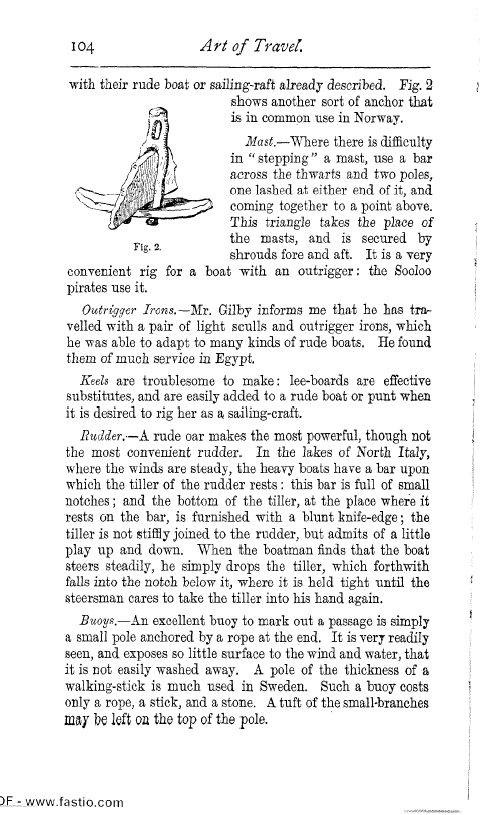| ||||||

OCR Rendition - approximate104 Art of Travel. with their rude boat or sailing-raft already described. Fig. 2 shows another sort of anchor that is m common use in Norway. Mast.-Where there is difficulty in " stepping " a mast, use a bar across the thwarts and two poles, one lashed at either end of it, and coming together to a point above. This triangle takes the place of the masts, and is secured by shrouds fore and aft. It is a very convenient rig for a boat with an outrigger : the Sooloo pirates use it. Outrigger Irons.-Mr. Gilby informs me that he has travelled with a pair of light sculls and outrigger irons, which he was able to adapt to many kinds of rude boats. He found them of much service in Egypt. Keels are troublesome to make : lee-boards are effective substitutes, and are easily added to a rude boat or punt when it is desired to rig her as a sailing-craft. Rudder..-A rude oar makes the most powerful, though not the most convenient rudder. In the lakes of North Italy, where the winds are steady, the heavy boats have a bar upon which the tiller of the rudder rests : this bar is full of small notches ; and the bottom of the tiller, at the place where it rests on the bar, is furnished with a blunt knife-edge ; the tiller is not stiffly joined to the rudder, but admits of a little play up and down. When the boatman finds that the boat steers steadily, he simply drops the tiller, which forthwith falls into the notch below it, where it is held tight until the steersman cares to take the tiller into his hand again. Buoys.-An excellent buoy to mark out a passage is simply a small pole anchored by a rope at the end. It is very readily seen, and exposes so little surface to the wind and water, that it is not easily washed away. A pole of the thickness of a walking-stick is much used in Sweden. Such a buoy costs only a rope, a stick, and a stone. A tuft of the small-branches may be left of the top of the pole. Fig, 2. ).F,,, www.fastio.com |